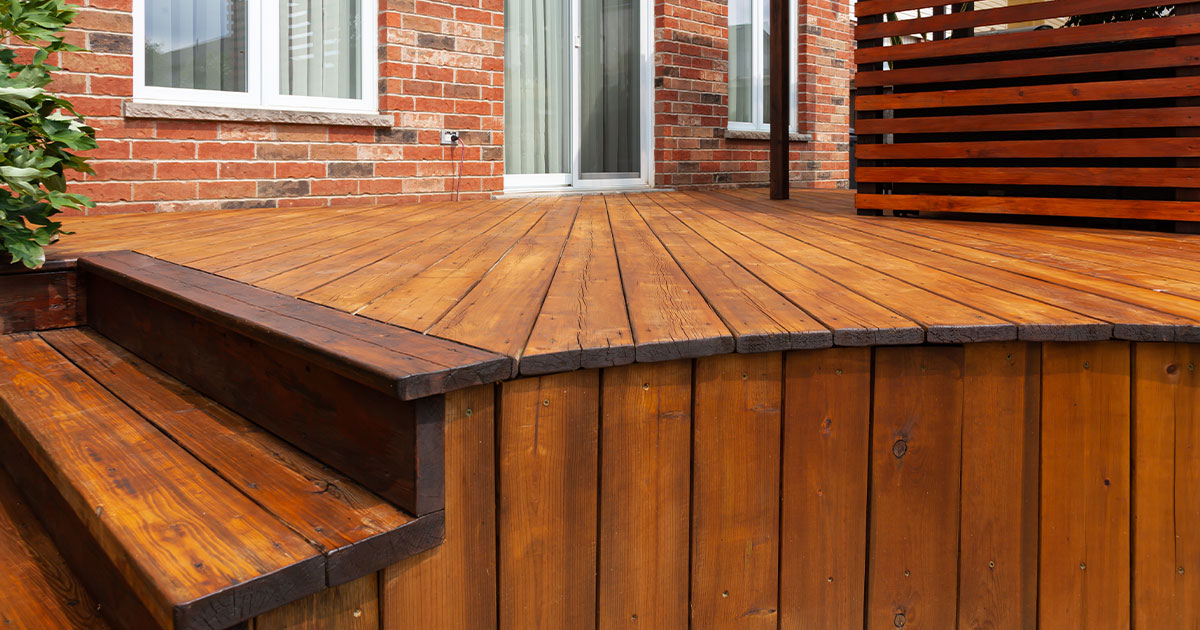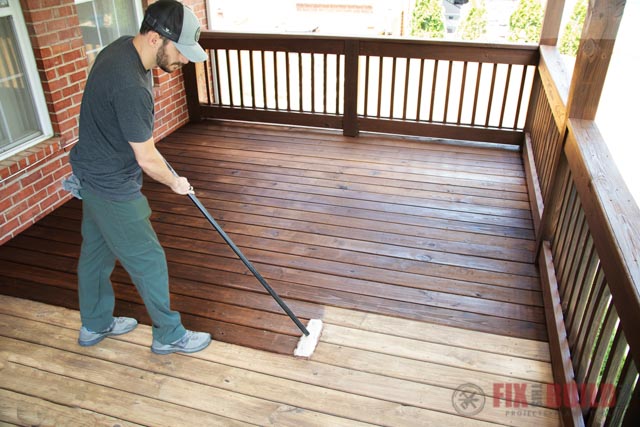Water-Based Stains for a Beautiful Deck: Eco-Friendly and Effective
Wiki Article
A Comprehensive Guide to Different Sorts Of Deck Staining Techniques for Ultimate Security and Visual Appeals
In the world of deck maintenance, the art of staining stands as a crucial step in the direction of both maintaining the stability of your outdoor space and improving its visual allure. As we navigate via the complex world of deck discoloration methods, one begins to value the nuanced methods that can make all the distinction between a sub-par coating and a flawless one.Recognizing Different Kinds of Spots
Numerous kinds of stains are commonly used in the process of deck staining to attain different visual and protective impacts. Transparent spots are optimal for showcasing the all-natural grain of the wood while supplying very little protection against UV rays and moisture. On the various other hand, semi-transparent stains use an equilibrium in between shade enhancement and security, permitting some wood grain to reveal through. For a much more nontransparent finish that offers optimum defense against the aspects, strong discolorations are the preferred option. These discolorations come in a wide variety of colors and successfully hide the timber grain.Toners include a hint of color to the timber while giving marginal security, making them appropriate for newer decks with less wear. Understanding the characteristics and benefits of each kind of discolor is important for accomplishing the desired look and toughness for your deck.
Selecting the Right Stain Shade
When thinking about the aesthetics of your deck discoloration task, the selection of discolor shade plays a crucial duty in improving the protective high qualities of the selected tarnish type (Chicago Deck Staining). The color you choose can substantially affect the overall appearance of your deck, in addition to its ability to hold up against the aspects over timeWhen selecting a tarnish color, it's necessary to take into consideration the existing color pattern of your home's exterior. Integrating the deck tarnish with the general aesthetic of your property can produce a aesthetically appealing and natural outdoor area. In addition, the color of your deck tarnish can influence the temperature level of the deck surface; darker shades tend to take in even more heat, while lighter shades show sunshine and stay cooler.
Additionally, the type of wood you are discoloring will certainly likewise influence exactly how the tarnish color appears. Various timber species can communicate with the tarnish in various ways, possibly modifying the last color. It's a good idea to check the discolor on a little, unnoticeable area of the deck to ensure the color transforms out as desired before waging the entire task.
Preparing Your Deck for Discoloration
To ensure a lasting and effective deck discoloration task, extensive prep work of the deck surface is essential. Begin by cleaning the deck thoroughly to get rid of dust, gunk, mildew, and any type of old end up or tarnish. Make use of a deck cleaner or a mixture of water and cleaning agent along with a tight brush or pressure washing machine to scrub the surface area tidy. After cleaning, allow the deck to completely dry completely before relocating on to the following step.Check the deck for any type of damaged or rotten boards that need to be changed. Hammer down any type of extending nails and sand any type of rough locations to his explanation make certain a smooth surface area for staining. Check for any kind of loosened railings or steps that might need tightening or fixing.
As soon as the deck is clean, completely dry, and in great repair work, take into consideration using a wood brightener to recover the deck's natural shade and open up the timber pores for better tarnish penetration. Protect any type of neighboring plants, furniture, or surface areas with plastic sheeting before continuing with the staining procedure. Correct preparation is crucial to achieving a professional-looking surface and taking full advantage of the longevity of your deck discolor.
Using Discoloration With Different Methods
For a remarkable and professional surface, the technique of using stain plays a critical role in improving the look and resilience of your deck. There are several methods you can use to make sure a reliable application of tarnish.It is suitable for elaborate locations and getting to between deck boards. Back-brushing after rolling is suggested to even out the stain and work it right into the wood for better infiltration.
Splashing is an additional prominent method, providing speed and simplicity of application, especially for large deck locations. It is vital to make use of a top quality sprayer and be mindful of overspray. Pad applicators provide a smooth and also end up and appropriate for both upright and straight surfaces. Whichever technique you pick, making certain correct prep work and complying with manufacturer standards will aid attain a resilient and lovely discolor coating on your deck.

Keeping and Re-staining Your Deck
When it comes to re-staining your deck, the regularity depends on various aspects such as the type of tarnish utilized, the environment in see this your area, and just how much wear and tear your deck experiences. Typically, it is advised to re-stain your deck every 2-4 years to preserve its defense and aesthetic appeals.Before re-staining, make sure the deck is clean, completely dry, and free of any type of previous tarnish residue. Fining sand might be required to ravel rough locations or get rid of old stain that is flaking. Pick a premium tarnish that suits your deck's product and provides the preferred degree of defense. Apply the discolor equally using navigate here the suitable method discussed earlier in this guide to make certain a long-lasting and gorgeous surface - Chicago Deck Staining. By staying positive with maintenance and re-staining, you can appreciate a visually appealing and well-protected deck for many years to come.
Conclusion
To conclude, understanding the different kinds of deck spots, picking the ideal shade, correctly preparing the deck, applying tarnish with various techniques, and re-staining the deck and maintaining are essential steps for ultimate protection and aesthetic appeals. By complying with these steps, you can guarantee that your deck continues to be in leading condition for many years to find.Furthermore, the color of your deck tarnish can affect the temperature of the deck surface; darker shades often tend to soak up even more heat, while lighter colors mirror sunlight and stay cooler.
It's advisable to examine the discolor on a little, inconspicuous location of the deck to make sure the color transforms out as preferred before continuing with the entire task.

Report this wiki page